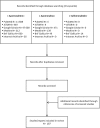The Many Faces of Apomorphine: Lessons from the Past and Challenges for the Future
- PMID: 29546602
- PMCID: PMC5995787
- DOI: 10.1007/s40268-018-0230-3
The Many Faces of Apomorphine: Lessons from the Past and Challenges for the Future
Erratum in
-
Correction to: The Many Faces of Apomorphine: Lessons from the Past and Challenges for the Future.Drugs R D. 2018 Jun;18(2):161. doi: 10.1007/s40268-018-0233-0. Drugs R D. 2018. PMID: 29737467 Free PMC article.
Abstract
Apomorphine is now recognized as the oldest antiparkinsonian drug on the market. Though still underused, it is increasingly prescribed in Europe for patients with advanced Parkinson's disease (PD) with motor fluctuations. However, its history is far from being limited to movement disorders. This paper traces the history of apomorphine, from its earliest empirical use, to its synthesis, pharmacological development, and numerous indications in human and veterinary medicine, in light of its most recent uses and newest challenges. From shamanic rituals in ancient Egypt and Mesoamerica, to the treatment of erectile dysfunction, from being discarded as a pharmacological tool to becoming an essential antiparkinsonian drug, the path of apomorphine in the therapeutic armamentarium has been tortuous and punctuated by setbacks and groundbreaking discoveries. Throughout history, three main clinical indications stood out: emetic (gastric emptying, respiratory disorders, aversive conditioning), sedative (mental disorders, clinical anesthesia, alcoholism), and antiparkinsonian (fluctuations). New indications may arise in the future, both in PD (palliative care, nonmotor symptoms, withdrawal of oral dopaminergic medication), and outside PD, with promising work in neuroprotection or addiction.
Conflict of interest statement
Funding
This research did not receive any specific grant from funding agencies in the public, commercial, or not-for-profit sectors.
Conflicts of Interest
The authors declare that there are no conflicts of interest relevant to this work.
Financial Disclosure
Dr. Manon Auffret: none. Dr. Sophie Drapier served on scientific advisory boards for Orkyn and Aguettant, received speech honorarium from Orkyn, Aguettant, Medtronic, and Teva, and received PHRC grants from the French Ministry of Health (unrelated to this article). Prof. Marc Vérin served on scientific advisory boards for Orkyn and Aguettant and received speech honorarium from Orkyn, Aguettant, Medtronic, and Teva (unrelated to this article).
Figures



References
-
- Sharma JC, Macnamara L, Hasoon M, Vassallo M. Diagnostic and therapeutic value of apomorphine in Parkinsonian patients. Int J Clin Pract. 2004;58(11):1028–1032. - PubMed
-
- Trenkwalder C, Ray CK, García RPJ, LeWitt P, Katzenschlager R, Sixel-Döring F, et al. Expert consensus group report on the use of apomorphine in the treatment of parkinson’s disease—clinical practice recommendations. Parkinsonism Relat Disord. 2015;21(9):1023–1030. - PubMed
-
- Emboden WA. Transcultural use of narcotic water lilies in ancient Egyptian and Maya drug ritual. J Ethnopharmacol. 1981;3(1):39–83. - PubMed
Publication types
MeSH terms
Substances
LinkOut - more resources
Full Text Sources
Other Literature Sources
Molecular Biology Databases
Miscellaneous

